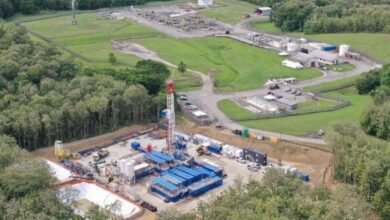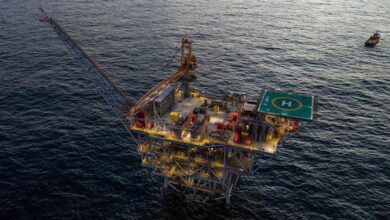Analysis: Global land rig demand may reach 7,300 by 2015
Chinese onshore rig count now greater than in Canada and Russia, report says
By Georgie Macfarlan, Andrew Reid, Rod Westwood and Matt Loffman, Douglas-Westwood

According to Douglas-Westwood analysis, total onshore drilling demand may reach a requirement for more than 7,300 active rigs drilling by 2015, with 52% of the demand coming from regions outside North America. In China, for example, the count is now greater than those in Canada and Russia. The global development of unconventional gas outside of North America will also have a profound effect on the global rig fleet toward the end of this decade. To meet the forecast production figures for European shale gas, for example, high-HP rig construction in the region would need to increase by over 1,000%.
North American market
The North American drilling market is the most documented in the world, with information regarding available and active rig fleets on a state-by-state basis kept by government and industry organizations. The market itself is highly commoditised and is marked by the presence of a large number of relatively small contractors that compete predominantly on price for an equally large volume of work.
The majority of North American drilling activity is in the hands of local oil and gas operators, while national oil company (NOC) presence is almost nonexistent. The vast number of small indigenous operators in the US is partially due to a legal regime that provides exploration rights to landowners; the US is the only country in the world with such a regime.
Dayrates are also lower in North America in part due to greater well program efficiency and the ability to easily move rigs between developments. Meanwhile, the oversupply of oilfield service and the numbers of companies operating in the US and Canadian markets do not represent a norm compared with other major regional bases of drilling activity.
Data from the Douglas-Westwood World Land Rig Market Report, which provides analysis of the international drilling markets in frontier and developing regions, as well as the established North American market, show that the global supply of land rigs is provided by more than 400 contractors, with the latest count exceeding 7,400 rigs. North America continues to lead the way in drilling and workover rig supply, although the majority of rigs are operating outside the US and Canada.
North American Market Hit Hardest
The growth in land rig demand since the beginning of the 21st century has been exceptional. Globally, the volume of rigs drilling for oil and gas increased by more than 100% between 2002 and 2008. Inevitably, North America accounted for a large proportion of this growth, although other key regions such as Russia and Middle East/North Africa (MENA) also contributed substantially to the growing demand for active drilling units.
It is estimated that at the start of 2008, an average of more than 6,200 rigs were actively drilling. Demand faltered in 2009, with the effects of the global economic recession reducing the operational rig fleet to an estimated 4,800. Although drilling demand fell in all primary hydrocarbon-producing regions, the demand reduction was led by North America – a market that has historically been highly sensitive to commodity prices. The widespread use of short-term contracts facilitated the rapid cutback of well requirements, compounding the steep decline in rig demand.
Outside of North America, reductions were far less severe. While key markets such as the mature provinces of Russia saw decline, much of this was E&A-driven. Ongoing development activity remained more stable due to the necessity to offset production declines in mature regions. The combination of a less sensitive international drilling market and a higher proportion of drilled wells present outside of North America led to a less dramatic downturn than in previous cycles. Furthermore, many operators work on yearly contracts, leading them to react slower to market trends and movements.
Strong Demand Growth in International Market
The outlook is clear: While North American demand has been re-incentivised through growth in commodity prices, activity in the region is unlikely to reach historic levels. Internationally, the opposite is true, with strong demand growth expected over the next five years and beyond. Douglas-Westwood estimates that growth in rig demand will average in excess of 5% per annum over the next five years, with strong growth set to occur within key markets on each continent.
Mexico will become an increased focus within Latin America, due primarily to increased expenditure by Pemex on exploratory activities. Although the mature environments of Libya and Egypt may witness a flat profile, other key MENA countries – including Saudi Arabia, UAE and most notably Iraq – are all expected to see substantial growth in the volume of rigs. In countries such as Algeria and Libya, the majority of this rig demand will be seen for horizontal and deviated drilling. Companies will seek to maintain production in maturing oil fields, and over 80% of newbuild demand will be for high HP rigs.
Douglas-Westwood’s analysis concludes that, by 2015, total onshore drilling demand may require more than 7,300 active rigs, and 52% of that demand will come from outside North America.
Growth of such scale inevitably requires an increased volume of rig construction – to increase the number of rigs currently available in international markets and to repair and replace existing fleets, which have suffered from a lack of investment over the last few decades.
Increased transparency on the part of Chinese contractors, particularly CNPC and its subsidiaries, confirms that the Chinese count is now greater than those in Canada and Russia; a number of other countries are also experiencing growth following the economic downturn in 2009. The increased activity and demand requirements are not solely from North America, with higher growth rates now evident in other regions, particularly MENA. Development of Chinese rig-building firms was particularly evident given the new opportunity to enter the global market.
Competition between manufacturers of rig components in frontier and international markets is strong. More than 100 companies now provide drawworks worldwide, with many of these also providing mud pumps and top drives. Development outside North America arguably provides more opportunities for oilfield service companies than producers, due to the number of NOCs within frontier markets.
Unconventional Development
Outside North America, the global development of unconventional gas will also have a profound effect on the global rig fleet toward the end of this decade. North America has experienced a steep increase in high-HP drilling rig demand as a result of rapid shale and tight-gas development over the past five years, while directional drilling is set to increase by nearly 25% over the next five years.
A total of 40% of US rigs are currently drilling directional wells while the vast majority of operational rigs are high-spec and of good quality. However, the size and specification of existing rig fleets in other regions will need to be increased dramatically to meet predicted E&A and well development demand. Although common across all regions, Europe and Australia will see the largest demand increases.
To meet the forecast production figures for European shale gas, for example, high-HP rig construction in the region would need to increase by over 1,000%.
Fleet Age, Reserve Maturity
Future demand within the rig market and the requirement to construct new fleet will be driven primarily by the age of rigs. The existing fleet is aging rapidly, the average rig 20 years old. The maintenance and replacement of this fleet is necessary in order to ensure suitability for continued and, in many cases, accelerated drilling programs.
Older rigs are likely to continue to be used for the drilling of in-fill wells. Equally, the complexity and depth of wells is increasing on a global basis. The depth of wells is increasing in key operating environments, such as Russia and MENA, while the use of deviated drilling is increasing, particularly within prolific gas-producing basins. Between 2010 and 2015, the global fleet of higher-HP rigs is set to increase by 46%, compared with only 27% for lower-HP rigs over the same period.
Newbuild activity has resumed in order to satisfy increased demand and to replace the aging fleet. Rig manufacturing capacity was put under pressure, and firms across the world prospered.
Recent activity has remained strong. While economic turmoil has put downward pressure on the number of rigs required to be working, this downturn has impacted to a lesser extent to previous cycles, and demand remains, relatively speaking, high.
Douglas-Westwood has been monitoring the global land drilling market for years through a network of NOCs, IOCs, nationalized drilling companies, and small independent contractors. Its World Land Rig Market Report provides insight into lesser-known markets within Europe, Africa, Asia, the Middle East and Latin America.




